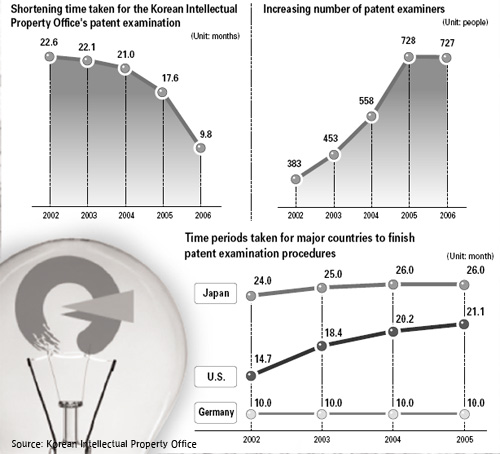They want their inventors to be first to market new technologies.

With new technologies coming out every second, it’s difficult for ordinary people to tell who was first to develop them. Accordingly, someone who invents something will try to be the first to obtain a patent, the official right to be the only person allowed to use or sell the invention.
The competition to obtain a patent is called a “patent war.”
Now that competition for patents has heated up, patent authorities in different countries around the world are in a race to shorten the time that it takes to examine new technologies and decide whether to issue patents on them. Because technologies develop rapidly and vary, authorities need to process patent applications quickly.
If the process is slow, individuals or companies who have developed new technologies will miss opportunities to use or sell them, and companies that want to purchase and make use of new technologies will not be able to do so.
South Korea has the fastest record in the world in patent examination procedures. For patents issued in December 2006, it took 9.8 months for the Korean Intellectual Property Office to examine inventions and issue patents on them. The country has overtaken Germany, which had been the fastest, taking 10 months in patent examination procedures.
What are these patent examination procedures? All procedures begin with an individual or company application for a patent. Companies or individual inventors submit in person or through the Internet a written application containing the name and an explanation of a new technology.
The Korean Intellectual Property Office determines whether the new technology can be applied to industry, whether it can be commercialized, whether it is new and whether it is in some way superior to older technologies.
A rigorous examination is needed to prevent causing damage to a third party if a patent, an exclusive right over the technology, is issued. If the authorities conclude that it will cause no problem to issue a patent, the applicant is allowed to register his patent after a prescribed waiting period, which gives other parties a chance to object if they wish to do so.
Until 2002, it took a minimum of 22 months on average for the Korean Intellectual Property Office to go through those procedures. But in recent years, South Korea has shortened the time dramatically.
Streamlining efforts at the patent office began after the Federation of Korean Industries, an organization of the nation’s business leaders, released a survey report in 2002 on “companies’ difficulties regarding the local intellectual property rights system.”
The report showed that slow patent examination procedures were bringing about economic losses of 1.5 trillion won ($1.6 billion) per year. The findings spurred the patent authorities to reform the system.
To shorten the time period for patent examination, the Korean Intellectual Property Office has greatly increased the number of its examiners. In 2003 the office employed 70 new examiners to increase the total number of examiners from 383 to 453. Since then, the office has continued to add new examiners every year. At present, the office has 727 patent examiners.
In addition, the office began regular evaluations of each examiner. Thanks to the new evaluation system, erroneous examinations were reduced from 3.6 percent of total cases in 2004 to 2.2 percent in 2006.
The shortened period for examination procedures has been welcomed particularly by small and medium-sized companies. Bang Gyu-yong, head of the patent team of Top Engineering Co., a mid-sized semiconductor and display manufacturing equipment producer, said, “Local and foreign chipmakers, who had expressed doubts about our company’s technology, now trust us and are making contracts with us, as we have obtained patents.”
In general, in large companies, a research and development project takes around five years. But in small and medium-sized companies, the process is shorter, taking one to two years. Accordingly, if they can receive patents for technologies quickly, they also can commercialize them quickly.
That was the impact that the Korean Intellectual Property Office intended to have in cutting the time for patent examination. Jun Sang-woo, head of the patent authority, said, “If new inventions become exclusive rights quickly, new technologies will be applied to products quickly, enabling the inventors fast entry to the market.”
As it has become global knowledge that the Korean Intellectual Property Office has shortened the time for examination procedures, giant companies from other developed countries are rushing to apply to gain international patents from Korea’s patent authorities.
Last year, Microsoft, the U.S.-based software giant, asked the Korean authorities for preliminary examination of 166 technologies for international patents.
Patent authorities in other developed countries, stimulated by the initiative of their Korean counterparts, have declared that they would also shorten their examination procedures. The United States said it will reduce the time for its procedures to 14.7 months by 2008, and Japan will aim for a period of 11 months by 2013.
German patent authorities are aiming to shorten their process to eight months within one or two years ― an effort clearly aimed to take back the top position from South Korea in the processing of patent applications.
By Shim Jae-woo JoongAng Ilbo [symoon@joongang.co.kr]










with the Korea JoongAng Daily
To write comments, please log in to one of the accounts.
Standards Board Policy (0/250자)